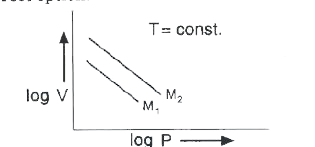Three different gases x,y,z of molecular masses 2, 16 and 64 were enclosed in a vessel at a constant temperature is correct
Gas z will be at the top of the vessel
Gas y will be at the bottom and x will be at the top
Gas x will be at the bottom and y will be at the top
Gases will form a homogeneous mixture
The correct Answer is:D
As the volume of the bubble at the surface becomes 8 times, pressure at the bottom of the lake is 8 times the pressure at the surface. As pressure on the surface = 1 atm, pressure at the bottom = 8 atm.
Thus, pressure due to the depth of the lake = 7 atm = 70 m of water.
Topper's Solved these Questions
- STATE OF MATTER (GASEOUS AND LIQUID STATE)BOOK - DINESH PUBLICATIONCHAPTER - STATE OF MATTER (GASEOUS AND LIQUID STATE)EXERCISE - Selected straight objective types MCQs
58 Videos
- STATE OF MATTER (GASEOUS AND LIQUID STATE)BOOK - DINESH PUBLICATIONCHAPTER - STATE OF MATTER (GASEOUS AND LIQUID STATE)EXERCISE - Linked Comprhension type MCQs
11 Videos
- STATE OF MATTER (GASEOUS AND LIQUID STATE)BOOK - DINESH PUBLICATIONCHAPTER - STATE OF MATTER (GASEOUS AND LIQUID STATE)EXERCISE - Ulitmate Preparatory package
20 Videos
- S-BLOCK ELEMENTS (ALKALI AND ALKALINE EARTH METALS )BOOK - DINESH PUBLICATIONCHAPTER - S-BLOCK ELEMENTS (ALKALI AND ALKALINE EARTH METALS )EXERCISE - Assertion reason
12 Videos
- STATES OF MATTER (SOLID STATE CHEMISTRY)BOOK - DINESH PUBLICATIONCHAPTER - STATES OF MATTER (SOLID STATE CHEMISTRY)EXERCISE - ULTIMATE PREPARATORY PACKAGE
21 Videos
Similar Questions
Three different gases X, Y and Z of molecular masses 2, 16 and 64 were enclosed in a vessel at constant temperature till equilbrium is reaches. Which of the following statement is correct?
View SolutionTwo non-reactive monoatomic ideal gases have their atomic masses in the ratio 2:3. The ratio of their partial pressures, when enclosed in a vessel kept at a constant temperature, is 4:3. The ratio of their densities is
View Solution
Knowledge Check
Three different gases X, Y and Z of molecular masses 2, 16 and 64 were enclosed in a vessel at constant temperature till equilbrium is reaches. Which of the following statement is correct?
AGas Z will be at the top of the vessel.BGas Z will be at the bottom and X will be at the top.CGas X will be at the bottom and Z will be at the top.DGases will form homogeneous mixture.Three different gases X, Y and Z of molecular masses 2, 16 and 64 were enclosed in a vessel at constant temperature till equilbrium is reaches. Which of the following statement is correct?
AGas Z will be at the top of the vesselBGas Y will be at the top of the vesselCGas X will be at the bottom and Z will be at the topDGases wil form homogeneous mixtureThree different gases X, Y and Z of molecular masses 2, 16 and 64 were enclosed in a vessel at constant temperature till equilbrium is reaches. Which of the following statement is correct?
AGas Z will be at the top of the vesselBGas Y will be at the top of the vesselCGas Z will be at the bottom and X will be at the topDGases will form homogenous mixture
The ratio of their partial pressures of two non-reactive monoatomic ideal gases when enclosed in a vessel kept at a constant temperature is 1:2. Their atomic masses in the ratio 4: 5. The ratio of their densities is
View SolutionTwo non-reactive monoatomic ideal gases have their atomic masses in the ratio 2:3. The ratio of their partial pressures, when enclosed in a vessel kept at a constant temperature, is 4:3. The ratio of their densities is
View SolutionTwo non-reactive monoatomic ideal gases have their atomic masses in the ratio 2:3. The ratio of their partial pressures, when enclosed in a vessel kept at a constant temperature, is 4:3. The ratio of their densities is
View SolutionFor same mass of two different ideal gases of molecular weights M1andM2 plots of log V vs log P at a given constant temperature are shown. Identify the correct option.

View Solution
For same mass of two different ideal gases of molecular weights M1 and M2 plots oflog V vs lot P at a given constant temperature are shown. Identify the correct option
View Solution
